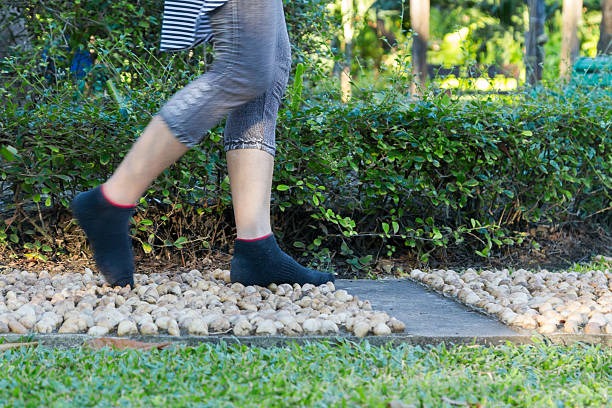The Benefits of Reflexology Path Paving: More Than Just Aesthetic Appeal
2/25/20255 min read


What is Reflexology Path Paving?
Reflexology path paving is an innovative outdoor design concept that merges aesthetics with wellness by utilizing textured stones to create therapeutic pathways. These paths are purposely designed to stimulate points on the feet that correspond to different organs and systems in the human body, a principle rooted in the practice of reflexology. Practitioners and enthusiasts alike believe that walking on these specially crafted surfaces can promote physical and mental well-being.
The foundation of reflexology lies in the belief that the feet are directly connected to various parts of the body, including internal organs, glands, and even the brain. This connection is increasingly recognized in wellness practices, where the art of reflexology is employed for relaxation, stress relief, and pain management. Reflexology path paving essentially converts a traditional walking experience into an engaging therapeutic activity, encouraging foot stimulation and enhancing overall health.
Typically, these paths are constructed using a variety of natural materials, such as pebbles, stones, and gravel, each chosen for their unique textures and shapes. These tactile elements are not only visually appealing but also serve a functional purpose. As individuals walk along the reflexology path, the uneven surfaces engage the foot's nerve endings and trigger a reflexive response in related body systems. This interaction is thought to encourage circulation, reduce tension, and improve mobility, making reflexology paths a popular addition to wellness retreats, gardens, and parks.
The growing popularity of reflexology path paving reflects a broader trend towards holistic health solutions that prioritize experiential learning and personal well-being. As people increasingly seek out environments that promote health benefits alongside visual beauty, reflexology paths provide an effective fusion of these elements. Such designs facilitate a deeper connection to nature while fostering a proactive approach to personal health, making them an appealing feature in modern outdoor spaces.
Health Benefits: Enhancing Circulation and Stress Relief
Reflexology paths, specially designed with various textures and materials, can significantly contribute to human health by enhancing circulation and providing effective stress relief. Reflexology itself is an ancient practice rooted in the belief that stimulating specific pressure points on the feet and body correlates to improved health in various organ systems. Walking on a reflexology path engages these pressure points, promoting blood flow, which is essential for overall well-being.
Scientific studies suggest that reflexology can help reduce stress levels through the positive influence of foot massage and pressure application. For instance, a research publication in the Journal of Alternative and Complementary Medicine indicates that individuals who engaged in reflexology sessions reported lower levels of anxiety, improved mood, and overall relaxation. This evidence suggests that the practice of walking on reflexology paths can result in similar, if not greater, benefits due to the perpetual movement involved, thereby providing continuous stimulation to these crucial pressure zones.
Moreover, enhanced circulation through the use of reflexology paths benefits not only the cardiovascular system but also facilitates the delivery of vital nutrients and oxygen to various cells and tissues. This heightened blood flow can aid in physical recovery, reduce fatigue, and minimize discomfort associated with prolonged periods of inactivity. To incorporate reflexology paths into daily routines, one may consider visiting local wellness centers, parks with designated paths, or even creating a home setup with assorted surfaces, such as pebbles and wood chips, to experience the health benefits regularly.
Utilizing reflexology paths as part of a holistic approach to health can facilitate not just a physical activity outlet, but also a mental escape, providing individuals an accessible means to enhance their overall quality of life.
Creating an Engaging and Therapeutic Outdoor Experience
Reflexology paths represent an innovative approach to enhancing outdoor spaces, transforming them into environments that promote physical and psychological well-being. These specialized pathways, composed of various textured stones and materials, are designed to stimulate the reflex points on the feet, offering a sensory experience that can have profound effects on relaxation and mindfulness. The act of walking on these paths encourages individuals to focus on their surroundings, engaging their senses to absorb the sights, sounds, and textures present, ultimately fostering a greater sense of presence in the moment.
The tactile interaction with the stones not only heightens awareness but also provides a natural form of therapy. As individuals navigate the uneven surfaces, they activate different areas of their feet that correspond to different organs and systems in the body, mirroring the principles of traditional reflexology. This process can lead to a range of benefits, including improved circulation, reduced stress levels, and increased energy. Furthermore, the psychological impacts of spending time in nature and engaging with a unique sensory experience should not be overlooked. Many studies suggest that natural environments are crucial in reducing anxiety and promoting overall mental health.
Successful installations of reflexology paths can be witnessed in numerous parks, gardens, and spas, contributing to community health initiatives and personal wellness retreats. For instance, several urban parks have introduced these paths as part of a holistic approach to public health, encouraging visitors to take a moment for themselves amidst their busy lives. Additionally, spas have adopted reflexology pathways as part of their relaxation areas, allowing clients to unwind fully before or after treatments. By creating engaging and therapeutic environments, these paths not only enhance the aesthetic appeal of outdoor spaces but also cultivate an atmosphere of health and well-being.
Aesthetic Enhancement: Unique Designs for Garden Landscapes
Reflexology paths are not only beneficial for physical and mental well-being but also serve a significant role in elevating the aesthetic appeal of garden landscapes. These uniquely designed paths incorporate various elements that contribute to their visual attractiveness while simultaneously providing health benefits. When integrating reflexology paths into a landscape, thoughtful consideration of design elements such as patterns, materials, and colors can transform an ordinary garden into a captivating retreat.
The design of reflexology paths often features a variety of textures and colors that invite exploration and engagement. For instance, natural stones, pebbles, or wood can be used to construct the path, each offering distinct sensory experiences as one walks over them. The interplay of colors, from earthy tones to vibrant hues, can create focal points within the landscape, guiding the eye and encouraging movement throughout the space. By selecting materials that harmonize with existing flora, gardeners can ensure that the reflexology pathways blend seamlessly into the natural environment while standing as aesthetically pleasing highlights.
In addition to the immediate beautification of a garden, well-designed reflexology paths can significantly enhance property value. Prospective buyers often seek unique features that contribute to a property's charm and character. A reflexology path is not just an aesthetic addition; it is a thoughtful element that sets a property apart, attracting visitors and enhancing the overall appeal of the space. Moreover, the incorporation of reflexology paths in garden landscapes can be a talking point, sparking interest and admiration from guests.
In conclusion, reflexology paths infuse garden landscapes with unique designs that offer both visual and physical gratification. By thoughtfully integrating various materials, colors, and textures, homeowners can create inviting and valuable outdoor spaces that entice visitors while promoting wellness.
